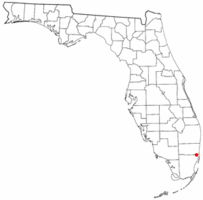
Lauderdale Lakes is a city in Broward County, Florida, United States. It is part of the Miami metropolitan area of South Florida. As of the 2020 United States Census, the city's population was 35,954.
Miami Gardens was a census-designated place (CDP) in Broward County, Florida, United States. The population was 2,706 at the 2000 census.

Miramar is a city in southern Broward County, Florida, United States. It is a key suburb of the Miami metropolitan area, which was home to 6.14 million people in 2020. As of the 2020 census, the population was 134,721, making it the second-largest city in Broward County, the fourth-largest city in the Miami metro area, and the 11th-largest city in Florida.

North Lauderdale is a city in Broward County, Florida, United States. It is a principal city of the Miami metropolitan area. As of the 2020 census, the city's population was 44,794.

Oakland Park, officially the City of Oakland Park, is a city in Broward County, Florida, United States. It is part of the South Florida metropolitan area, which was home to 6,166,488 people at the 2020 census. As of the 2020 United States Census, the city's population was 44,229.

Pembroke Park is a town in Broward County, Florida, United States. The town took its name from its location along Pembroke Road. It is part of the South Florida metropolitan area. Almost one-half of its residents live in mobile homes. As of the 2020 census, the population was 6,260.

Andover is a neighborhood in Miami Gardens, Florida. It was formerly a census-designated place. The population was 8,489 at the 2000 census. Transmitters for several Miami television stations are located in Andover.
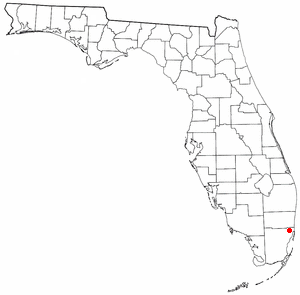
Bunche Park is a neighborhood in Miami Gardens, Florida, United States. It was formerly a census-designated place.

Biscayne Gardens is a census-designated place (CDP) in Miami-Dade County, Florida, United States. It is part of the Miami metropolitan area of South Florida. The population was 32,499 at the 2020 US census.

Goulds is an unincorporated community and census-designated place (CDP) in Miami-Dade County, Florida, United States. The area was originally populated as the result of a stop on the Florida East Coast Railroad. The railroad depot was located near the current Southwest 224th Street. The community was named after its operator, Lyman Gould, who cut trees for railroad ties. It is part of the Miami metropolitan area of South Florida. As of the 2020 US census, the population stood at 11,446, up from 10,103 in 2010 US census.
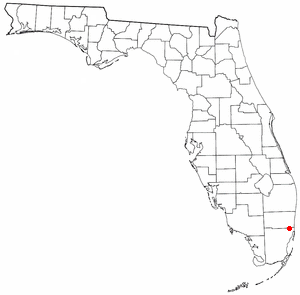
Lake Lucerne is a neighborhood in Miami Gardens, Florida. It is formerly a census-designated place. The population was 9,132 at the time of the 2000 United States census.
Norland, also known as Norwood, is a former census-designated place located in northern Miami-Dade County, Florida. The population was 22,995 at the 2000 census. The latest estimated population stands at 23,500. In 2003 the majority of this CDP was incorporated into the city of Miami Gardens, and it now serves as one of the city's neighborhoods.

North Miami Beach is a city in Miami-Dade County, Florida, United States. The City of North Miami Beach is part of the Miami metropolitan area of South Florida. Originally named "Fulford-by-the-Sea" in 1926, after Captain William H. Fulford of the U.S. Coast Guard, the city was renamed "North Miami Beach" in 1931. The population was 43,676 at the 2020 US census.
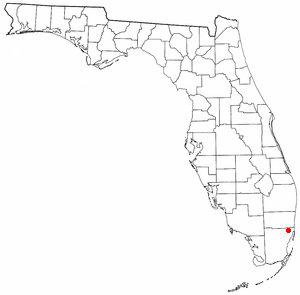
Opa-locka North is a neighborhood in Miami Gardens, Florida, United States. It was formerly a census-designated place. The population was 6,224 at the 2000 census.
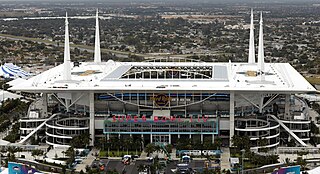
Scott Lake is a neighborhood in Miami Gardens, Florida. It was formerly its own census-designated place. The population was 14,401 at the 2000 census.

Atlantis is a city in Palm Beach County, Florida, United States. It is part of the Miami metropolitan area of South Florida. As of the 2020 census, the city had a population of 2,142.
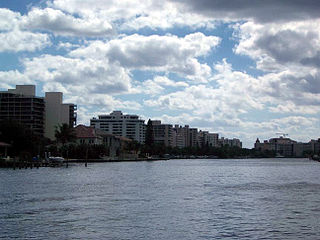
Highland Beach is a town in Palm Beach County, Florida, United States. It is part of the Miami metropolitan area of South Florida, and situated 50 miles north of Miami and 28 miles south of Palm Beach. As of the 2020 US census, the population was 4,295.

Lake Park is a town in Palm Beach County, Florida, United States. Lake Park is part of the Miami metropolitan area of South Florida. The population was 9,047 at the 2020 US census.

Mangonia Park is a town in Palm Beach County, Florida, United States. It is a part of the Miami metropolitan area of South Florida as well as Uptown West Palm, which includes the cities of Riviera Beach and West Palm Beach. As of 2020, the population recorded by the U.S. Census Bureau was 2,142.
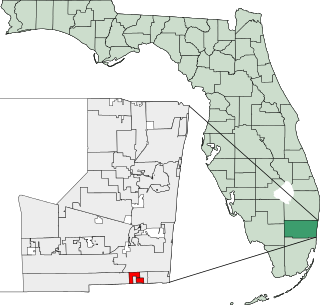
West Park, officially the City of West Park, is a municipality in Broward County, Florida, United States. It was created on March 1, 2005. West Park is part of Miami metropolitan area of South Florida. It is located in the southeastern part of the county and consists of the neighborhoods of Carver Ranches, Lake Forest, Miami Gardens, and Utopia. A large portion of the city lies west of the town of Pembroke Park, so the new city was called "West Park". The city has a population of 15,130 as of the 2020 census.
